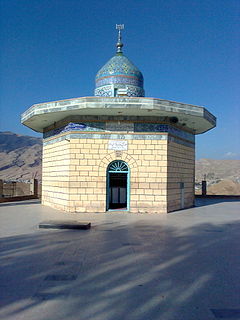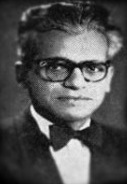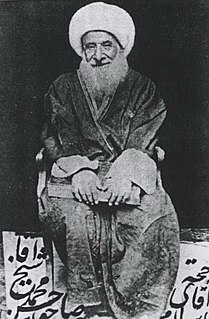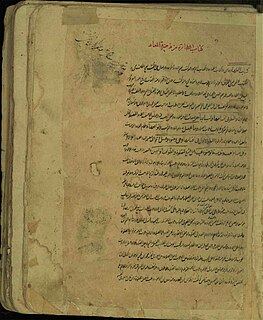This article needs additional citations for verification .(July 2018) |

Sheikh Jafar ibn Hussein ibn Ali Shooshtari (born 1230 AH, 1814/1815 AD, died 20 Safar 1303 AH/28 November 1885) was a prominent Shia scholar from the city of Shooshtar.
This article needs additional citations for verification .(July 2018) |

Sheikh Jafar ibn Hussein ibn Ali Shooshtari (born 1230 AH, 1814/1815 AD, died 20 Safar 1303 AH/28 November 1885) was a prominent Shia scholar from the city of Shooshtar.
He was born in 1230 AH in Shooshtar. He was a descendant of Ali ibn Hussain Najjar who was a great Shia scholar of 11th century AH. His paternal lineage is as follows: Jafar son of Hussein son of Hassan son of Ali son of Ali AlNajjar Shooshtari. He moved to Kadhimiya in early childhood with his father. He was taught by Sheikh Mohammad Al-e-Yasin, Sheikh AbdulNabi Kazemi and Sheikh Ismail ibn Asadollah Kazemi. He then returned to Shooshtar and then went to Karbala to study under Sheikh Mohammad Hossein Esfahani and Sharif ol Olama. Then he moved to Najaf to study under Sheikh Ansari. He returned to Shooshtar in 1255 AH and wrote "Menhaj ol Ershad" and built a Husseinya. In 1287 AH the tomb of prophet Daniel in Susa was repaired by the order of Shaikh Jafar in the hands of Haj Mulla Hassan Memar. [1] Then he returned to Karbala. He then made a trip to Iran to visit the tomb of Ali Al-Ridha. On the way, he stopped at Ray, where many scholars and clerics on the order of Naser al-Din Shah Qajar visited him and asked him to stay in Tehran. He accepted and moved to Tehran and held the prayers in Marvi Mosque.
Sheikh Jafar was such a gifted speaker and his sermons were so emotional that they attracted thousands. The number of attendees grew so much that Marvi Mosque could not fit the crowd anymore. With the suggestion of Naser al-Din Shah Qajar, he moved to Sepahsalar Mosque, and according to one of his students, 40,000 people attended his sermons. His sermons were so emotional, that often even clerics in the audience started weeping. Many have reported that Nasser Al-Din Shah Qajar himself was often coming to his sermons in an anonymous outfit.
After spending some time in Tehran, he made a trip to Mashhad and then returned to Tehran again. Shah suggested that he should stay in Tehran, but he said that he wants to be buried next to his master Ali Ibn Abi Talib in Najaf. [2]
Sheikh Jafar became ill on his way to Iraq to visit the tomb of Ali ibn Abi Talib and died in the Karand area between Iran and Iraq. His students moved his body to Iraq and buried him there. There is a mosque in Najaf in his honor.

The Shāh Abdol-Azīm Shrine, also known as Shabdolazim, located in Rey, Iran, contains the tomb of ‘Abdul ‘Adhīm ibn ‘Abdillāh al-Hasanī. Shah Abdol Azim was a fifth generation descendant of Hasan ibn ‘Alī and a companion of Muhammad al-Taqī. He was entombed here after his death in the 9th century.

Traditionally, Iranian architects were known as Mi'mars.

The Shrine of Fatima Masumeh is located in Qom, which is considered by Shia Muslims to be the second most sacred city in Iran after Mashhad.

Donboli is a Turkic-speaking Kurdish tribe living around Khoy and Salmas in West Azerbaijan Province in Iran.

Kamran Mirza, was a Persian Prince of Qajar Dynasty and third surviving son of Nasser al-Din Shah. He was the brother of Mass'oud Mirza Zell-e Soltan and Mozzafar al-Din Shah. He was also the progenitor of the Kamrani Family. He might have been Prime minister of Iran for a few days in April–May 1909, but this is not clearly referenced. Kamran Mirza also served as Iran's Commander-in-Chief, appointed in 1868 for the first time, and minister of war from 1880 to 1896 and from 1906 to 1907.

Seyyed Nematollah Jazayeri was a prominent Shia scholar born in 1640 and died in 1700, in one of the islands around Basra. He was one of the grandchildren of Musa al-Kadhim. His paternal lineage is as follows: Seyyed Ne'mat Allah son of Seyyed Abd Allah son of Mohammad son of Hossein son of Ahmad son of Mahmoud son of Ghias Aldin son of Majd Aldin son of Noor Aldin son of Saad Allah son of Issa son of Musa son of Abdallah son of Musa al-Kadhim.

Seyyed Mohammad-Ali Emam-Shooshtari was a prominent Iranian historian and religious scholar.

Grand Ayatollah Sheikh Muhammad-Hasan al-Najafi, also known as Sahib al-Jawahir, was a prominent Shiite religious authority and author. He was most known for his books of Jawahir al-Kalam Fi Sharh Shara’i‘ al-Islam, a 42-volume work on fiqh.

Ayatollah Seyed ‘Abd al-Husayn Mousavi Dezfuli Najafi Lari, was one of the clergymen and jurists from South Iran who advocated creating a constitution and had a major role during the nomads’ war against British forces in First World War.

Grand Ayatollah Mulla Muhammad Ashrafi was a leading Iranian Shia Marja' in Mazandaran; Iran from roughly 1839 to his death in 1898. His Father Mulla Muhammad Mehdi was one of the Ulama of Behshahr. He was his first teacher and thought him primary cleric subjects and tried to nurture him with shia knowledge and Ahl Al-Bait friendship and love.

Mirza Yusuf Ashtiani also known as Mostowfi ol-Mamalek was the Grand Vizier of Iran during the reign of Nasser al-Din Shah and one of the most influential members of Qajar bureaucratic system at that time. He was from the conservative faction of the Qajar court and an opponent of Mirza Hosein Khan Moshir od-Dowleh and his reforms.

Mostowfi ol-Mamalek was One of the positions and titles of the Iranian court from the Ilkhanid period to the Qajar era.
Mirza Abolghasem Gilani, known as Mirza-ye Qomi, the author of the book of Qawanin al-Usul, was a Shiite jurist (Faqīh), mujtahid, fundamentalist (Usuli) and a religious reference (Marja') during the reign of Fath Ali Shah Qajar in the twelfth century AH. Mirza-ye Qomi was active and famous in poetry and calligraphy. He has left more than fifty thousand verses of poetry in Persian and Arabic, as well as writings in Naskh and Nastaliq scripts.

Grand Ayatollah Sheikh Mohammad Ibrahim al-Karbasi known as Sahib al-Isharat was a Shia jurist, mujtahid, fundamentalist, Quran commentator, theologian, scholar of biographical evaluation and marja', and considered the reviver of the Isfahan Seminary in the 19th-century.

The Isfahan Seminary is one of the oldest seminaries in Isfahan, Iran. Currently, more than 40 schools in Isfahan province are under the supervision of the Management Center of Isfahan Seminary and the leadership of the supreme authority of Grand Ayatollah Hossein Mazaheri.

Mohammad Bagher Sabzevari known as Mohaghegh Sabzevari was an Iranian Faqih and Shiite scholar from the 11th century AH, Shaykh al-Islām and the Imam of Friday Prayer of Isfahan.

Ali Akbar Qavam ol-Molk was an Iranian statesman who served as the kalantar of Shiraz and Custodian of Astan Quds Razavi in Qajar period. he was the youngest son of Hajji Ebrahim Shirazi, the grand vizier of Fath-Ali Shah who by the latter's order was executed, his family too, subsequently purged. Ali Akbar was one of the survivors. Later for appeasement by the orders of Fath-Ali Shah, his family lands were returned and he became the kalantar of Shiraz thus marking the start of Qavam family.

Sheikh Nasrallah Shah-Abadi Persian: شیخ نصرالله شاه آبادی, was an Iranian Ayatollah. He represented the people of Tehran Province in the Fifth term of the Assembly of Experts.